High school aviary is for the (adopted) birds

It’s eighth period and the last class of the day at Farmington High School in northern Utah. And while most of the hallways are clear, there is one area that’s bustling with activity. Students are busy washing dishes, chopping fruit and preparing pellets, seeds and nuts. They’re wiping down windows, sifting sand and scrubbing a jungle gym of branches, all with an excited chorus of squawking and chirping in the background.
These are the advanced students of Farmington High’s ornithology program ― the “aviary staff” as teacher and science director Adam Blundell calls them. They are in charge of what may be the country’s first high school aviary, as well as all the adopted birds within it. Almost a dozen birds are from Best Friends Animal Sanctuary, adopted to their one-of-a-kind home.
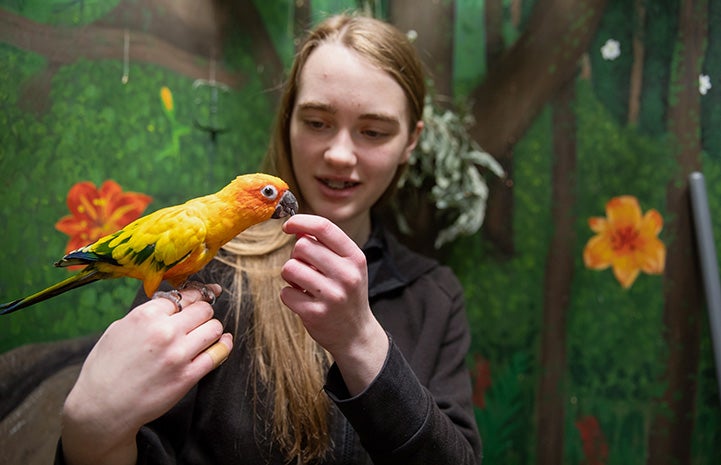
Aviary developed, maintained by students
Farmington High School has always offered an ornithology class, something Adam says was only natural, given the school’s location. “Our high school is literally on the shores of the Farmington Bay Waterfowl Management Area,” he explains. “When you’re building a high school that happens to be right on the wetlands, right in that whole migratory system, it just simply makes sense to have a science class (utilizing) that.”
Students in the program started studying the local birds of the area. Then animal care was introduced, with students taking care of some domestic lovebirds and parakeets in the classroom. And while it was certainly a unique class that stood out from your typical high school chemistry, physics or biology course, the students wanted something more ― experience with a wider variety of birds and a larger space to house them.
Adam and his students went looking for a space in the school that could be altered to suit their feathery purposes. They were thinking about an unused room in the basement or a closet they could co-opt but what they got was even better. When the principal heard what they wanted to do, he loved the idea and suggested a more central location, a conference room in the middle of the school where the birds could be a bright highlight to everyone’s day. The superintendent signed off on the location, and that afternoon they tore out the carpet.
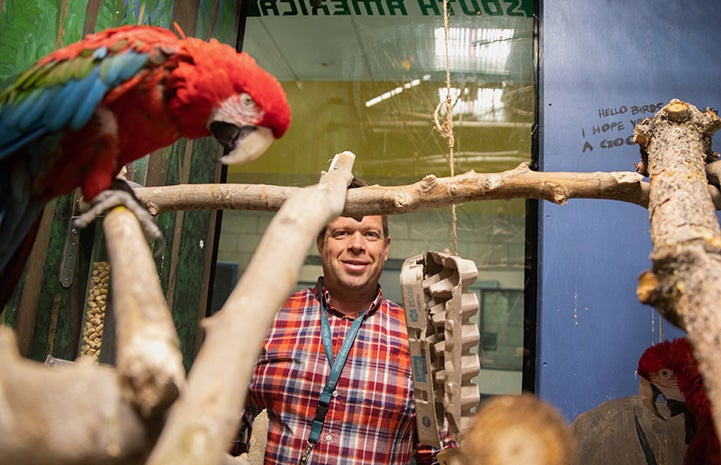
[Parrot with special needs goes home to the lap of luxury—literally]
The passion project of the ornithology department soon became a school-wide undertaking. Building supplies were purchased with donated funds and students in shop classes put together frames and dividing walls. The art department donated paints and students spent months designing immersive, life-size scenic murals for each of the themed areas: South America, Africa and Australia. Computer science students created an interactive app with information on the areas and birds.
Of course, no aviary would be complete without birds to call it home. And what better way to fill the beautiful new space than by adopting birds in need of homes? Some birds (the African section’s turaco, finches and weaver birds) came from nearby rescue and rehabilitation organizations. Others, such as the bright pair of green-winged macaws and the small flock of rosellas and grass parakeets, were adopted from Best Friends.
“I thought it might take years to come together,” Adam says, “but it was really about six months. Six months from when they said ‘You can have this room’ is when we had the grand opening, cut the ribbon and had all the birds in.”
With the aviary complete and birds dancing with students through the glass between classes, there was a surge in popularity for the program. Soon, there was a waiting list of high schoolers wanting to join the bird class. And, according to those who made it in, the experience does not disappoint.
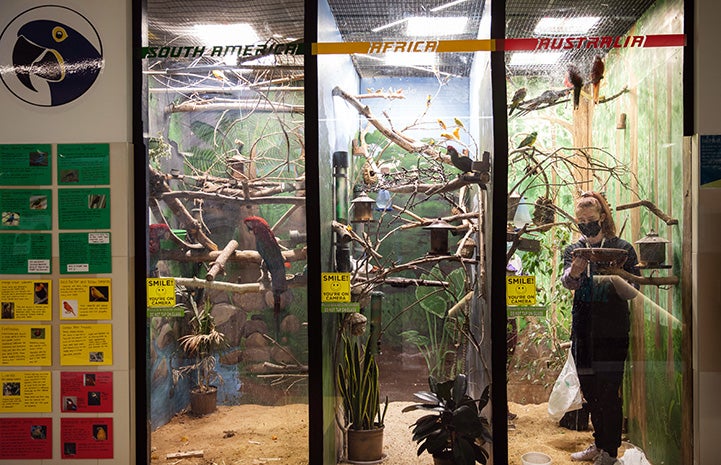
One-of-a-kind student experience
Eliana is one of the senior students in charge of the Australian section of the aviary. Adam describes her as extremely dedicated and it’s easy to see why. She is at the aviary every day, even coming in on weekends to care for the birds. She’s been in the program for two years and has developed a particular fondness for the shy parakeets.
Many of the small, colorful birds Eliana works with came from Best Friends. Rosellas and grass parakeets were hatched at a bird mill where they were overcrowded and had little human interaction before coming to the Sanctuary.
“They like to be up high mostly,” she says, “but there’s one who lets me feed her and she loves sesame seeds, so I’ll stick them up by her. She’s probably my favorite.” Eliana has nicknamed her TimTam after the Australian candy bar. All of the birds in her area have Australian names.
On the other side of the aviary are Lauren and Sam, students who are working with the macaws and conures of the South America section. In fact, it was Lauren who painted the towering trees and lush undergrowth on the walls of this area.
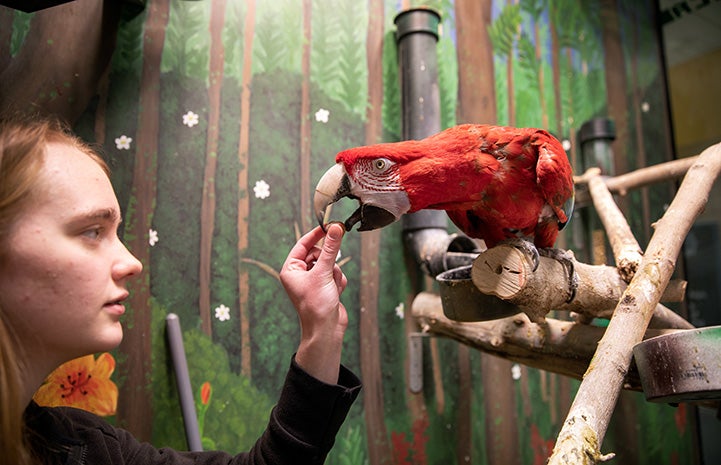
[How a once-homeless parrot hit the jackpot]
“We talked about painting the aviary over the summer and I did that for the summer and a portion of junior year,” she says. By the start of her senior year, the painting was complete. And since she was already so invested in the aviary, she decided to join the class.
Sam has been in the ornithology program for three years, even before the aviary was added. And while he admits his introduction to the class might have started with a girl and a choice between birds or physics, it was so fun he kept coming back. “It’s great, it’s fantastic,” he says. “Each bird has their own personality. Sunny (the little sun conure) loves to bathe more than anything in the world, which I thought was funny. He’ll just get in there (and) get soaked.”
Sam has also been working with Arco, a macaw from the Sanctuary who loves dancing around with visitors but still isn’t sure about being handled. “We’re getting there,” says Sam. “I just picked (him) up last time.”
All three students agree that seeing the birds’ different personalities has been one of the most fascinating aspects of the class, an experience not possible with birds in the wild. “A lot of times when you see animals out in nature,” says Eliana, “it’s like oh yeah, there’s a hawk, there’s a bird. But you don’t get to see their individual personalities as you do when you work closer with them and actually get to know them. That’s fun to see.
“I had no idea that (this) was a thing before I started working in the aviary,” says Lauren. “And then Sam was telling me (that) Sunny is nice and Arco is like this. Their personalities are super interesting.”
Not only are the students having fun discovering different aspects of their feathery friends but they’re also getting animal care work experience that may prove useful in the future. Sam has already been working at an avian specialist’s veterinary clinic, Eliana plans on studying wildlife biology in college and wants to work with animals in the future. And even Lauren, who plans to continue her art education, says she’ll be checking to see if her future school offers any interesting animal classes.
[Blue-fronted Amazon parrot lands in her perfect home]
As the seniors get ready for graduation, they’ll soon have the experience of training a new round of aviary staff to take over their responsibilities come summertime.
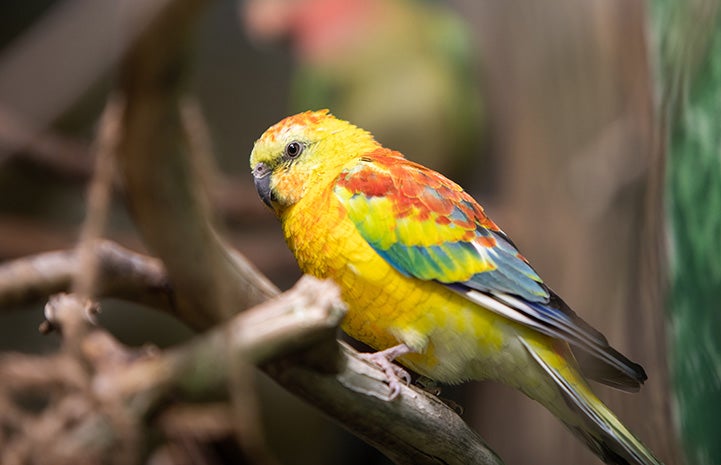
Flocking to the future
As the ornithology program and its colorful, energetic aviary residents continue to draw in new students, Adam says he is pleased with where they find themselves. But, he says, there’s always the chance to expand in the future. On the opposite side of the old conference room-turned-aviary, a fourth space is painted with a snowy landscape. For now, it remains empty until inspiration strikes.
With a summer class on the horizon, the birds won’t any time soon find themselves short on friends, cleaners or entertainment. When their current caregivers graduate, there will be a new round of teens to discover their personalities, little quirks, favorite foods and pastimes. Along the way, they’ll be helping to open doors and pave paths for more students interested in working with animals. And if you ask Arco, TimTam and the other birds from the Sanctuary, it doesn’t get much better than that.

Find a flock of your own
If you’re a fan of all that’s fine and feathered, there are many more birds looking for loving homes just like yours.
Read more:
Adopted cat lands a job and lives a life worthy of a storybook ending
Out of more than 100 foster pets, volunteer adopts the blind senior dachshund
Wild mustang mares and foals make Best Friends their winter rest stop